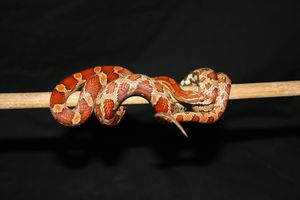
COMMON NAME: Corn Snake,
SCIENTIFIC NAME: Pantherophis guttatus
Corn snakes (Pantherophis guttatus) are to North America found predominantly in forests and woodlands of the southeastern United States. These snakes make popular pets as they are docile, non-venomous, and come in a large variety of color patterns and morphs. Corn snakes reach 2-5 feet in length as adults and may live upwards of 20 years in captivity.
Adult corn snakes require at least a 30-gallon terrarium, but juveniles can be kept in smaller enclosures. It is important that the enclosure has a secure lid and/or doors to prevent these escape artists from getting loose.
Providing a loose substrate that allows your snake to burrow while simultaneously helping maintain humidity in the enclosure is ideal. Cypress mulch and aspen shavings are appropriate choices. Avoid pine or cedar shavings as they can cause respiratory irritation. Sand, corncob, and soil substrates should also be avoided due to the risk of impactions if swallowed.
Provide two hide boxes within the enclosure, one on the warm and the other on the cool side. These should be fairly snug, at most 50% bigger than the snake, for the snake to feel secure. Provide a humid hide in the enclosure by filling one of the hide boxes with moist sphagnum moss. Placing branches or climbing toys in the enclosure can help provide enrichment and many corn snakes will climb readily if they are provided.
A heat gradient ranging from 75°F(24°C) on the cool end to 85°F(30°C) on the warm end should be present in the enclosure. At night, this can drop to 65°F-75°F (18-24°C). Good sources of heat for ball pythons include under-tank heat mats, radiant heat panels, or heat lamps. Avoid hot rocks as these cause serious burns. Always measure temperature with a digital thermometer. Utilizing a thermostat is recommended for all reptiles as it allows better control over temperatures and prevents the enclosure from over-heating.
Corn snakes have an optimum humidity range of 35-60%. When they are in the process of shedding, maintaining them at the higher end of this range can help encourage a healthy shed. Placing a hygrometer within the enclosure will allow you to monitor the humidity within.
Recent studies have shown that corn snakes are able to utilize UVB light to synthesize Vitamin D, an important vitamin used for absorbing calcium from the diet. Because of this, we now recommend providing UVB for 10-12 hours daily using a 5% UVB light source.
Captive corn snakes can happily subsist on a diet of whole rodents. Baby corn snakes should be fed pinkie mice, while adults should be fed appropriately sized adult rodents. These prey items should be no wider than your snake’s head. For both the welfare of the prey animal, and the safety of the corn snake, live prey should be avoided whenever possible and thawed frozen prey should be offered instead. Juvenile corn snakes should be fed twice weekly, whereas adult corn snakes will eat once every 7-10 days.
Providing a large, shallow water dish large enough for your corn snake to completely fit within will help provide humidity as well as provide them with drinking water. The water should be changed daily and the water dish cleaned at least once weekly or if visibly soiled.
Copyright © All Rights Reserved
